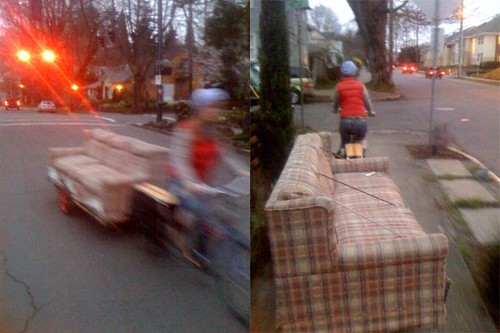I wrote about disability and adaptive bicycling for Grist this week in part because, this last winter, the topic hit home.
One day, shortly after the new year, my partner fell suddenly and mysteriously ill. For three months, on most days, he was barely able to get out of bed and walk across the house. He was diagnosed with a systemic bacterial infection — if you are lucky enough to be unfamiliar with such things, I’ll just say that the treatment makes you feel much worse before you get better.
After a few weeks of stress and cabin fever, we did what I assume any carfree household would do and bought a bamboo bike trailer.
I hitched it to the back of my xtracycle, Joe sat on a cushion on top of our upturned recycling bin, and off we went, slowly and laboriously. “Our first family car!” said Joe.
We got it almost entirely so that we could go on breakfast dates together. And it saved our asses. Joe could get out into the world beyond his recliner. For me, it was the perfect self-care regimen, like signing up for a cross-training bootcamp and running away to join the circus all at once. With the trailer, we could have adventures together again.
I don’t have any photos of the two of us traveling this way, unfortunately — but on one of the first days that Joe was back on his own two wheels, he snapped these shots of me hauling a sofa bed across town:
If you’re one of the many people we saw whipping out their phones to capture the spectacle of a small lady hauling a lanky guy on a crazy long cargo setup, please send pictures!
There’s a whole corner of the adaptive cycling world devoted to bikes two people can ride together. I like that. Being able to move around independently is important. Being able to help each other and be helped might be even better.
